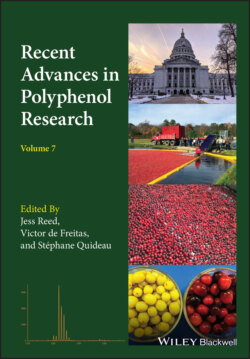Читать книгу Recent Advances in Polyphenol Research - Группа авторов - Страница 31
2.3.1 Hypothetical Biosynthetic Routes
ОглавлениеOn the biogenesis of the characteristic double linkages (A‐type), two putative pathways have been proposed (Paths I and II, Figure 2.7) (Selenski and Pettus 2006). Different consequences would be expected on the reactivity and the stereochemistry in the formation of the [3.3.1]bicyclo skeleton D. Path I entails the addition of the flavan nucleophile B to the electrophilic partner A, producing the singly linked dimer C (the B‐type structure). Oxidation at the C(2) position of the upper flavan unit in C allows the formation of a doubly linked derivative D (the A‐type structure). From the stereochemical standpoint, if the initial C–C bond is formed in a stereoselective manner, the stereochemistry generated by the subsequent C–O bond formation would be settled spontaneously, due to the steric constraints in the bicyclic skeleton. On the other hand, Path II is based on a formal [3+3]‐cycloaddition of the flavylium E with the flavan unit B. Since the flavylium E lacking any stereogenic centers is achiral (prochiral), the [3+3]‐cycloaddition reaction needs to proceed with enantiofacial selectivity, which may be regulated by enzymes in the biogenesis. These putative biosynthetic pathways would give hints to chemical synthesis.
Figure 2.5 Mayer's PA (procyanidin A2): the terminological origin of A/B‐type structures.
Figure 2.6 Structures of the tetramers with A‐type linkages.
Figure 2.7 Two plausible biosynthetic pathways forming the A‐type structure.
